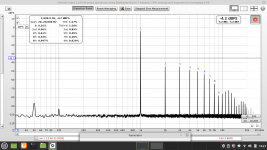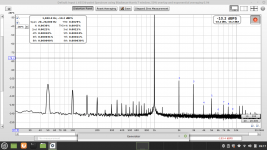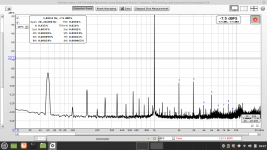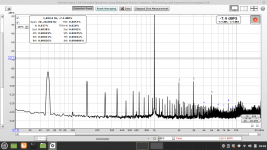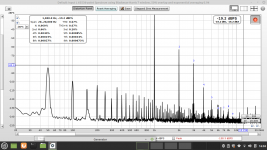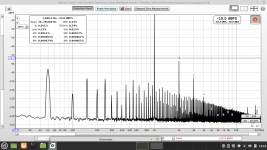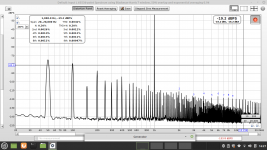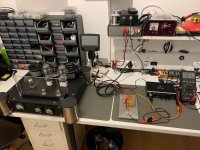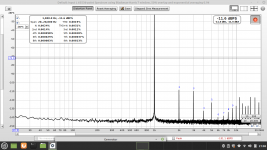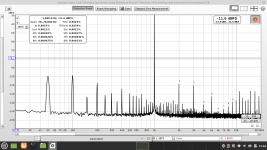Everything was the same except SW, knobs on sound card etc. I tried varying output level, but it stayed at the same -50 all the time. I don't care about the numbers in ARTA either, it's just about the visual presentation to me, and that one is off in REW.
No possibility to post screenshots any more, all disconnected and amp is back in the main system. Just hoping somebody who is measuring something could try the same thing.
No possibility to post screenshots any more, all disconnected and amp is back in the main system. Just hoping somebody who is measuring something could try the same thing.
Thank's
There aren't much difference... I will try to use XLR pin 2 & 3 for "balanced" input, and "tip" & "ring" for the output, to see if it will make a difference.
When turning both output and input to "zero" i get the same picture as before.
I can't seem to find anywhere howto adjust levels/RMS to make the loopback test, can some tell me the correct procedure ?
Jesper.
I tried this now, and when setting output-level to ~0.05v rms and input line to just before clipping (same as without pin 3 connected)...For using single ended to balanced you need to connect pin 1 (GND) and 3 (-ve) together and make that the RCA sleeve, pin 2 (+ve) to RCA center. Without the ground reference in SE mode it is very noisy.
There aren't much difference... I will try to use XLR pin 2 & 3 for "balanced" input, and "tip" & "ring" for the output, to see if it will make a difference.
When turning both output and input to "zero" i get the same picture as before.
I can't seem to find anywhere howto adjust levels/RMS to make the loopback test, can some tell me the correct procedure ?
Jesper.
Attachments
No issues I'm aware of with REW's multitone test.Everything was the same except SW, knobs on sound card etc. I tried varying output level, but it stayed at the same -50 all the time. I don't care about the numbers in ARTA either, it's just about the visual presentation to me, and that one is off in REW.
No possibility to post screenshots any more, all disconnected and amp is back in the main system. Just hoping somebody who is measuring something could try the same thing.
For best performance always use MINIMUM input gain setting at the soundcard. Then close the loopback and set output driving voltage for minimum THD+N reading.
I would expect something between -4 and -10dB FS input level as a sweetspot.
I would expect something between -4 and -10dB FS input level as a sweetspot.
Ahh... i got it...For best performance always use MINIMUM input gain setting at the soundcard. Then close the loopback and set output driving voltage for minimum THD+N reading.
I would expect something between -4 and -10dB FS input level as a sweetspot.
Thank's for clearing this out for me.
It appears to be the superposition of all signals causing a much higher peak-peak signal to occur than one would expect from just the peak magnitude of one of the tones. That then causes background clipping and hence a rise in the apparent signal floor. REW identifies when signal is clipping at digital full scale, but it is likely the level needs to back off a fair bit more for the floor level to go right down to where you expect it to be. The scope can be used to see the amplitude fluctuation.
Hi again here guy's 🙂
So i figured out, that the best performance doing loopback is with line-in level at "zero" and line-out at around 2 O'clock (100mV).
Plugs are still singleended (will try balanced later) for all 3. measurements here.
While i was at it i loaded my DCG-3 preamp(50K potmeter) with 10K on the output RCA's, and took some measurements at unitygain (E.g. 0.5Vrms input / 0.5Vrms output. inputlevel starts indicating clipping at around 0.750Vrms btw...)
It look's like they perform equal, which is good.
Laptop batterypowered, but measurements is taking on my lap., which i guess is noisy (50Hz Denmark)
Jesper.
So i figured out, that the best performance doing loopback is with line-in level at "zero" and line-out at around 2 O'clock (100mV).
Plugs are still singleended (will try balanced later) for all 3. measurements here.
While i was at it i loaded my DCG-3 preamp(50K potmeter) with 10K on the output RCA's, and took some measurements at unitygain (E.g. 0.5Vrms input / 0.5Vrms output. inputlevel starts indicating clipping at around 0.750Vrms btw...)
It look's like they perform equal, which is good.
Laptop batterypowered, but measurements is taking on my lap., which i guess is noisy (50Hz Denmark)
Jesper.
Attachments
Well done, this is what we were looking for. My loopback sweetspot using EMU-Tracker pre is around 0.002% THD+N corresponding to a SINAD of 94dB.Hi again here guy's 🙂
So i figured out, that the best performance doing loopback is with line-in level at "zero" and line-out at around 2 O'clock (100mV).
Plugs are still singleended (will try balanced later) for all 3. measurements here.
While i was at it i loaded my DCG-3 preamp(50K potmeter) with 10K on the output RCA's, and took some measurements at unitygain (E.g. 0.5Vrms input / 0.5Vrms output. inputlevel starts indicating clipping at around 0.750Vrms btw...)
It look's like they perform equal, which is good.
Laptop batterypowered, but measurements is taking on my lap., which i guess is noisy (50Hz Denmark)
Jesper.
So there is not very much room left for improvement now.
Thank's... this is fun actually...Well done, this is what we were looking for. My loopback sweetspot using EMU-Tracker pre is around 0.002% THD+N corresponding to a SINAD of 94dB.
So there is not very much room left for improvement now.
I did take measurements on my AlephMimi (Scaled down Aleph J), my GainClone and the 300B tupeamp i build 2019.
I post here the 3 left channel measurements.
All of them have the 50, 150, 200 etc... Hz spikes, but it looks as the 300B giving the most silent setup that is.
Also it looks like the 300B's giving the most 2.harmonic (what i also expected)
I must say through that either the Aleph & the 300B are giving any speakerHUM, even at highvolume and ear close to my +91dB speakers.
I also don't know if i will have the same 50Hz noise at livingroom? - The 50Hz is also down -70dB ---> -90dB on all 3 amp.'s
Jesper.
Attachments
That hum seems a bit high, could it be from the measurement setup? Seems you have balanced in on the sound card, so that should be good, as long as you are using it balanced, and not creating a ground loop? Did you try unplugging the PS to the laptop?
In the drop down selection on the upper left you can select the lowest option in the list (was it dBc?) to always have the scaling at 0dB for the test signal.
In the drop down selection on the upper left you can select the lowest option in the list (was it dBc?) to always have the scaling at 0dB for the test signal.
Agree...That hum seems a bit high, could it be from the measurement setup? Seems you have balanced in on the sound card, so that should be good, as long as you are using it balanced, and not creating a ground loop? Did you try unplugging the PS to the laptop?
In the drop down selection on the upper left you can select the lowest option in the list (was it dBc?) to always have the scaling at 0dB for the test signal.
I tried every possible connection, and figured out that the input & output can be used as balanced.
Nomatter what i try, making this loopback connection allways comes up with the big 50Hz bump.
I have a feeling that it's the USB supply from my laptop.
I don't have a nice clean 5vdc supply right here, if i had i would try splitting the USB cable, making the data+ / data- and GND go through and supply a clean supply on the vcc connection on the cable going into the Behringer.
Jesper.
Jesper, happy 2022!
You may want to have a look here...https://www.diyaudio.com/community/threads/behringer-umc-202hd-for-measurements.341309/ Be warned, your new toy is quite fragile. 🙂
You may want to have a look here...https://www.diyaudio.com/community/threads/behringer-umc-202hd-for-measurements.341309/ Be warned, your new toy is quite fragile. 🙂
lesson learned today.
The problem i had with the 50Hz and 2x, 3x, etc... spikes was actually it was placed on my lab-desk 🙄
I took two new loopback test's showing how much a few meters away from noisy enviroment gives!
It's really something, you can actually hold the Behringer onto the walls and find the wires inside the wall.
So next time i will measure my amp's, it's going to be far away from wires and plugs... 😊
Jesper.
The problem i had with the 50Hz and 2x, 3x, etc... spikes was actually it was placed on my lab-desk 🙄
I took two new loopback test's showing how much a few meters away from noisy enviroment gives!
It's really something, you can actually hold the Behringer onto the walls and find the wires inside the wall.
So next time i will measure my amp's, it's going to be far away from wires and plugs... 😊
Jesper.
Attachments
MagicBus... nice that you are here... and happy new year back from cold north.Jesper, happy 2022!
You may want to have a look here...https://www.diyaudio.com/community/threads/behringer-umc-202hd-for-measurements.341309/ Be warned, your new toy is quite fragile. 🙂
Strange i missed this thread of your's, will for sure read it!
Jesper...
Your first hum spectra showed a fundamental of 50Hz. 5V supplies and noisy wall-warts produce rectified ac with a fundamental of 100Hz with harmonics at 200Hz, 300Hz etc - but not at 150Hz. For that reason I would suspect air pickup along some coupling capacity from your wiring inside the tube amps - or even the wiring inside your soundcard - as you discovered meanwhile. Are you sure your interconnects are shielded?
Your first hum spectra showed a fundamental of 50Hz. 5V supplies and noisy wall-warts produce rectified ac with a fundamental of 100Hz with harmonics at 200Hz, 300Hz etc - but not at 150Hz. For that reason I would suspect air pickup along some coupling capacity from your wiring inside the tube amps - or even the wiring inside your soundcard - as you discovered meanwhile. Are you sure your interconnects are shielded?
Hello... and thanks for helping.
My interconnection inside the Tubeamp. is short shielded, but ofcause there are all kinds of "noisy" part's besides that inside.
I tried making some longer connection cables for the Behringer, so that i can have it at least 1.5m away from DUT.
When i go near 50Hz(and or other equipment) with the connection cables, the 50Hz++ spikes come back. -So this telling me, that there must be an issue
with the Behringer & connection cables picking up this noise.
I tried every possible connection techniques, XLR balanced/unbalanced on input, TR and TRS balanced/unbalanced on output. Not much difference here.
As i only use "lowFI" connection, thin shielded cables for now, i think there could be some issue with them being to cheap?
- Will have to tryout some thicker, better ones.
Anyway, i can see the harmonics which was my main goal, so nomatter what the Behringer is usefull, just a shame with the picky hum 😊
Any tricks i can use, tryout etc... Also if someone tried the Behringer - What are you connections (XLR/TRS/TS, cable etc... ) ?
Any hint appreciated!
Thanks all.
Jesper.
Most of the time I use 6.3mm TRS (i.e. balanced) with shielded cable. Cables are standard microphone cable. I assume your 50Hz noise is coupled capacitively. You may try a metal sheet between table-top and test equipment connected to ground as a shield. And keep in mind that a peak of -120dB is something in the range of uV!Hello... and thanks for helping.
My interconnection inside the Tubeamp. is short shielded, but ofcause there are all kinds of "noisy" part's besides that inside.
I tried making some longer connection cables for the Behringer, so that i can have it at least 1.5m away from DUT.
When i go near 50Hz(and or other equipment) with the connection cables, the 50Hz++ spikes come back. -So this telling me, that there must be an issue
with the Behringer & connection cables picking up this noise.
I tried every possible connection techniques, XLR balanced/unbalanced on input, TR and TRS balanced/unbalanced on output. Not much difference here.
As i only use "lowFI" connection, thin shielded cables for now, i think there could be some issue with them being to cheap?
- Will have to tryout some thicker, better ones.
Anyway, i can see the harmonics which was my main goal, so nomatter what the Behringer is usefull, just a shame with the picky hum 😊
Any tricks i can use, tryout etc... Also if someone tried the Behringer - What are you connections (XLR/TRS/TS, cable etc... ) ?
Any hint appreciated!
Thanks all.
Jesper.
- Home
- Design & Build
- Software Tools
- How to - Distortion Measurements with REW
